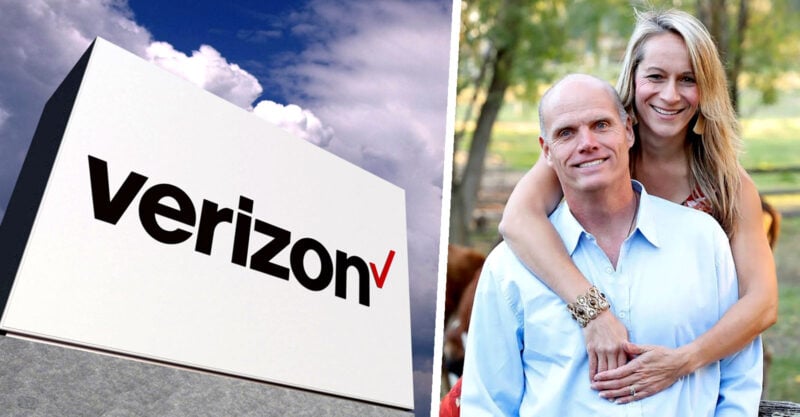Miss a day, miss a lot. Subscribe to The Defender's Top News of the Day. It's free.
An Idaho man alleging the radiofrequency radiation emitted by a cell tower installed next to his home triggered more than 15 episodes of atrial fibrillation today sued Verizon and other companies involved in the operation of the tower.
Henry “Hank” Allen, age 53, said his electromagnetic sensitivity (EMS) makes him vulnerable to life-threatening cardiac episodes, which began in April 2021, when Verizon activated the tower.
The lawsuit, funded by Children’s Health Defense (CHD) and filed in the U.S. District Court for the District of Idaho Southern Division, could set an important legal precedent that would help others with EMS who want to fight back against having a cell tower placed near where they live.
W. Scott McCollough, lead litigator for CHD’s Electromagnetic Radiation (EMR) and Wireless cases, told The Defender:
“It’s becoming really clear that this massive deployment of wireless technology everywhere is functionally prohibiting a large number of people from being able to participate in society or even live safely in their own homes.
“This case is designed to recognize the fact that wireless technology does indeed make a lot of people sick, and also to give them some much needed relief.”
In addition to Verizon, defendants in the suit include Horizon Tower LLC, which owns and operates the tower, and telecommunication providers AT&T and Dish Wireless, which also own and operate equipment at the tower site.
According to the lawsuit, Allen said the high levels of radiofrequency (RF) radiation emitted by the tower also exacerbated other EMS symptoms, including tinnitus, extreme fatigue, impaired memory and vision, sleep disruption, and flu-like symptoms.
EMS, sometimes called electromagnetic hypersensitivity (EHS) or microwave syndrome, is the “medical term” for a federally recognized condition — protected under the Americans with Disabilities Act (ADA) — in which individuals suffer adverse health effects due to electromagnetic field (EMF) exposure.
Up to 30% of the U.S. population experiences mild EHS, 1.5-5% have moderate cases of the condition, approximately 1.5% suffer severe cases like Allen’s, and approximately 0.65% cannot work at all because of their disability.
The complaint said Allen “lives and works in constant fear for his health and his very life” because of the constant RF exposure he is subjected to and the defendants “refuse to recognize the federal disability laws that would solve the conflict.”
McCollough said in a press release the lawsuit is a civil rights case that offers “a new legal theory” under the ADA:
“Federal courts must apply federal disability laws to protect people disabled by RF radiation coming from cell towers.
“If Hank’s case is successful, the court will either remove the tower, or otherwise order the telecom defendants to modify their operations in order to not so intensively beam RF radiation through Hank’s home so he can live in peace.”
More lawsuits like this are coming
Allen’s case is the first in a series of strategic cases that CHD will fund later this year and in 2024 on behalf of individuals with EMS, according to Miriam Eckenfels-Garcia, director of CHD’s EMR program.
“In these lawsuits, we are leveraging federal disability laws to petition for reasonable accommodation for clients that have been disabled by RF radiation coming from a cell tower near them,” Eckenfels-Garcia told The Defender.
In addition to protecting disabled people individually, she said, the cases are testing whether the ADA can be used “as an effective means to push back against the uncontrolled rollout of wireless infrastructure.”
“We are very excited to launch this new strategic line of cases, which we hope will shift the paradigm for people severely harmed and disabled by RF radiation,” she said.
McCollough said these cases are significant because the number of people affected by EHS is substantial. “We’re talking millions of people, and hundreds of thousands for whom it just ruins their lives completely.”
“The numbers are such that, frankly, we expect to find that it overwhelms the people who are already disabled by other causes,” he added, and people disabled by EHS must also be accommodated under the ADA.
Man moves to rural Idaho to escape RF radiation
Allen was diagnosed with EMS in 2014 while working as a licensed general contractor in California on job sites with high RF radiation.
After realizing how exposure to RF radiation was exacerbating his EMS symptoms, he and his family decided to relocate to a small farm in Idaho roughly two miles away from a cell tower.
Allen also changed careers to minimize his exposure to RF radiation by getting licensed as a real estate broker and working from his home, which he hardwired for internet access.
With these changes, Allen was able “to successfully live and work normally from home despite his disability” — until April 2021, when Verizon built a cell tower next to his property.
Shortly after Verizon turned on the tower, Allen’s health “took a dramatic downturn” as he suffered atrial fibrillation and was rushed to the emergency room “unsure whether he would live,” the complaint said.
A doctor did an echocardiogram, ran a full blood panel, did a cardioversion to restore a regular heartbeat and gave Allen IV drugs to slow his heart rate.
Two days later, it happened again.
In March 2022, Allen had invasive heart surgery — cardiac ablation — to treat the recurrent heart rhythm problems.
However, Verizon, AT&T and Dish in 2022 added additional antennas to the tower.
“This equipment … also triggers Mr. Allen’s severe and in some instances life-threatening symptoms associated with his recurring and ongoing disability,” stated Allen’s lawyers in an August 2023 letter to Verizon, AT&T and Dish in which they asked the companies to provide disability accommodations/modifications.
Allen has “exhausted all available self-help options,” according to the complaint, including painting his house with RF-blocking paint, tinting the windows with RF-blocking tint, utilizing wire screens and wearing special clothing that blocks RF.
The RF emitted by the transmitting equipment threatens the plaintiff’s life. “His condition is such that he may die as a result of the next cardiac event caused from RF exposure,” the complaint alleges.
The wireless companies responded to Allen’s request for a reasonable accommodation/modification by claiming that the federal disability laws do not apply to their tower operations because they do not meet the criteria for a “place of public accommodation.”
The “Courts of Appeals” are split, according to the complaint, on whether a “place” refers to an actual physical structure or whether it also applies to goods, services and privileges that are also offered “virtually.”
The complaint argues that the space on the tower leased to the telecommunications companies and associated infrastructure that are necessary to access the internet constitute a physical “place” subject to compliance with the ADA. It adds that given that access to the virtual realm is essential to modern life, it should also be considered a “place,” under the ADA.
Although Allen subscribes to wireless services, he cannot use them without accommodation because they severely exacerbate his disability.
Local residents didn’t want tower
A planning commission in Ada County, Idaho, granted Horizon a conditional use permit to construct the tower in 2018, the complaint says.
However, after local residents told their representatives that extra communications infrastructure was not necessary, elected Ada County representatives voted to overrule the commission and deny Horizon’s permit application.
The tower was very unpopular in the Eagle, Idaho, community, according to the complaint, which already had extensive broadband coverage that the city had paid to install and was not dependent on the tower or antennas.
Instead, the tower and antennas were useful and lucrative to wireless companies to expand private mobile data service.
Horizon appealed and Ada County settled the dispute by reinstating the conditional use permit. The tower and its first antennas were built in 2020 and 2021 and RF began transmitting from the tower in March 2021.
The plaintiff’s symptoms began soon thereafter.
Here’s what Allen wants from the lawsuit
Allen hopes the court will rule on at least three things.
First, he is asking the court to rule that provisions in the ADA apply to cell towers when they transmit RF radiation through the homes and bodies of EMS-disabled individuals.
In turn, Allen hopes the court will conclude that Horizon, Verizon, AT&T and Dish violated the ADA by refusing to engage in a good faith process to accommodate his disability and that he is entitled to a remedy that will allow him to access services without being substantially injured by them.
Second, he asked the court to end the defendants’ discrimination against him by mandating the tower be moved “to a new location that is reasonably calculated to avoid injuring the disabled population,” meaning that it wouldn’t be installed right next to other citizens with EMS.
Alternatively, he is asking the companies to be compelled to utilize their existing technological capabilities to adequately reduce the amount of RF energy directed at his home and body.
Third, he is asking the court to compel the companies to stop discriminating against him and instead make reasonable accommodations so he can access their services.
Allen is requesting a jury trial, where a jury can provide him with the requested relief, as well as attorney fees and costs.
Defendants could ‘easily’ accommodate Allen’s disability but refuse
According to McCollough, Allen has done “all he could” to mitigate the RF radiation levels in his home, but the nearby tower “continues to evoke severe symptoms.”
McCollough in the complaint said:
“Defendants [Verizon, AT&T and Dish] could easily and with minimal cost take action that would end these debilitating symptoms and permit Plaintiff to fully enjoy the use of the Defendant’s telecommunications services, but they have refused to do so, despite Plaintiff’s request for reasonable accommodations and/or modifications.”
The plaintiff has tailored his request in a way that would allow the defendants to remain compliant with federal communications laws without “fundamentally altering” their goods and services.
Yet the companies’ representatives “nonetheless insist” that the company owes no duty to Allen and “have refused to even consider any accommodation/modification.”
According to McCollough, the companies have refused because they are concerned that complying with disability accommodation/modification request “would open the door” to them “having to engage in a reasonable accommodation/modification dialogue with all other similarly-disabled Americans.”
The wireless companies’ resistance to doing so is based on what’s convenient for them — not what is legally required, McCollough argued.
If they are immune to the ADA, it would save them the “time and expense” of having to comply with federal disability law.
But there’s no legal precedence for that, McCollough said. “Communications providers have never been found exempt from federal disability law,” he added.
Watch attorney W. Scott McCollough discuss the case on CHD.TV:










